This colorful and flavorful vegan bibimbap is a take on the classic Korean dish! It is a combination of fresh vegetables, marinated baked tofu, brown rice, and topped with a spicy and sweet sauce. It’s a delicious way to eat the rainbow!

Japanese and Korean flavors are my absolute favorite! I fell in love with Asian cuisine when I was a kid! My best friend’s mom is Burmese, and she loved to cook. She introduced my family to unique Asian dishes.
About once a week my mom and I went out for lunch with my best friend and her mom. We usually went to Korean or Japanese. When we went to the Korean restaurant I always ordered bibimbap. I ordered it in a stone bowl which makes the rice so nice and crispy!
The rainbow of colors and the flavorful vegetables topped with the most amazing sweet and spicy sauce were addictive! It was such an explosion of umami flavor!
It all seemed so complicated that I never tried making my own bibimbap until now! This flavorful and simple vegan recipe! This dish also makes an excellent meal prep dinner!
Jump to:
What is bibimbap?
Bibimbap is a Korean dish made with rice, assorted vegetables, beef, and topped with a sunny-side-up fried egg. The translation of bibimbap is mixed rice with meat and vegetables.
There are many different varieties. When you go to a Korean restaurant you’ll find versions with beef, seafood, and tofu. It is also commonly accompanied by kimchi.
This version does not include beef or egg. Instead, marinated tofu is added for protein. Instead of kimchi, I’ve added spinach. Kimchi is usually made with fish sauce, thus not vegan friendly.
Although this version has some substitutions, the sauce is what really makes it pop! The traditional go-chu-jang sauce is a sweet and spicy hot pepper paste that must not be left out of this recipe!
Why You’ll Love This Vegan Bibimbap Recipe
- Healthy
- Flavorful
- Easy
- High in Protein
- Vegan and Vegetarian
- Egg-Free
- Dairy-Free
- Gluten-Free
- Great way to use up extra veggies!
- Hearty and Delicious
- Whole Food Plant-Based
- Oil-Free
Recipe Ingredients and Notes
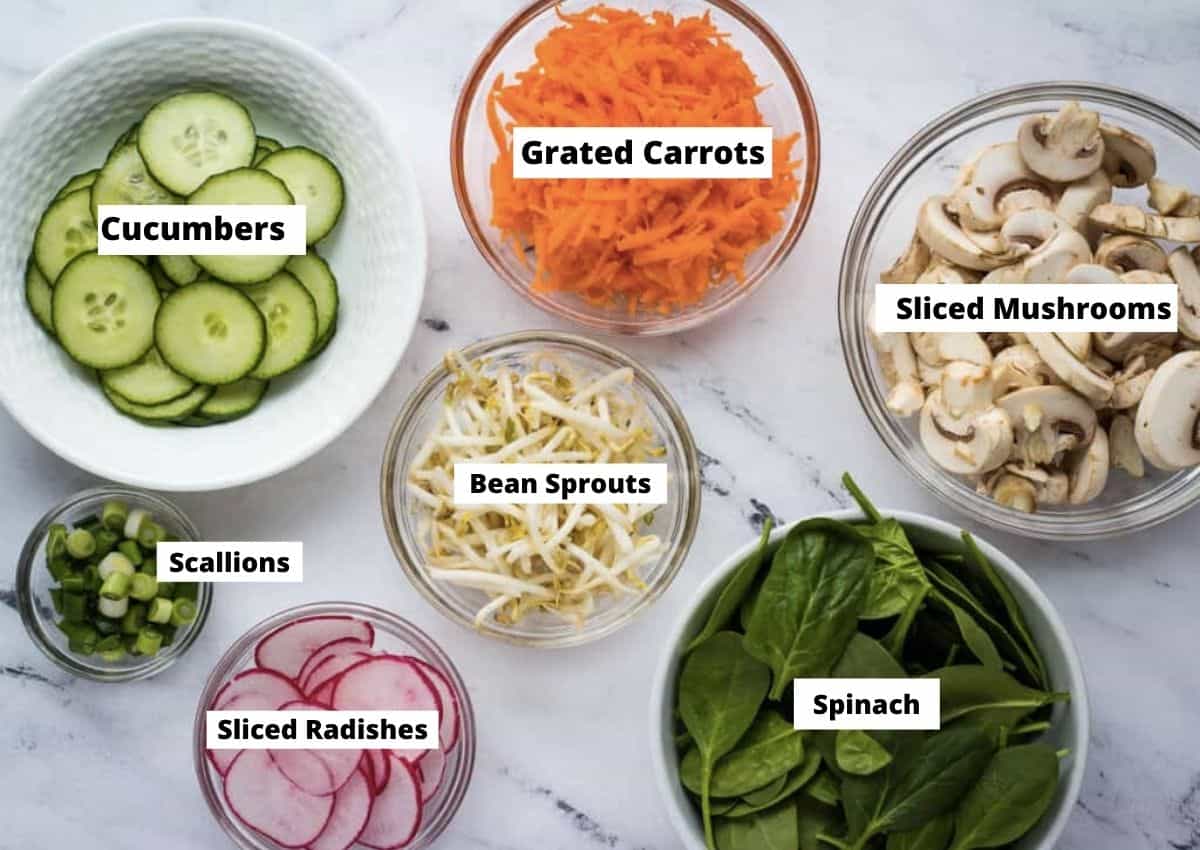
Vegetables: While you can use whatever vegetables you have in your fridge, I’ve chosen to use mushrooms, spinach, radishes, cucumber, mung bean sprouts, and green onions. You’ll need to prep the vegetables for easy assembly. Shred the carrot, and thinly slice the radishes, and cucumber. You can use any type of mushrooms you desire, I used mini Bellas, but shiitake mushrooms would work very well.
Brown Rice: Traditionally this dish is served with white rice, but to amp up the fiber, and use whole grains, I used brown rice.
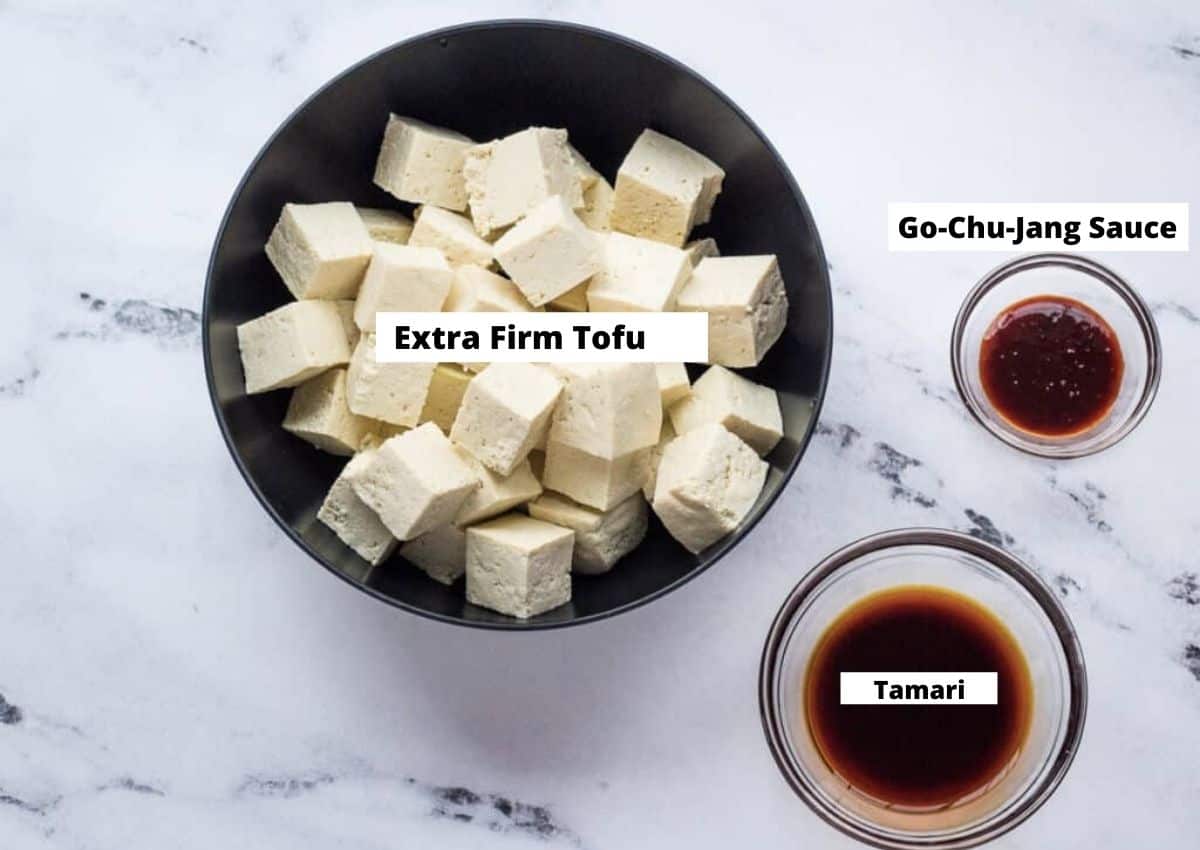
Tofu: You’ll need extra firm tofu. Be sure to press the water out of the tofu before marinating it in the tamari and go-chu-jang sauce.
Gochujang Sauce: This sweet and spicy sauce it what makes bibimbap so flavorful! It’s difficult to find in your typical grocery store. Check the ethnic food aisle. I had to order mine online!
How to Make Vegan Bibimbap – Step by Step
While making this bibimbap is not difficult it does have several steps, to create each component of the dish. You’ll need to prepare the brown rice, prepare the fresh vegetables, sauté the cooked vegetables, bake the tofu, and make the sauce. Then assemble all the pieces into your bowl.
Prepare the Tofu
Step 1:Press the block of tofu for 10-20 minutes to remove the access water. Use a tofu press. Or place several paper towels under and on top of the block of tofu. Place a heavy pot on top. Weight the pot with a few cans or jars. After 20 minutes remove paper towels.
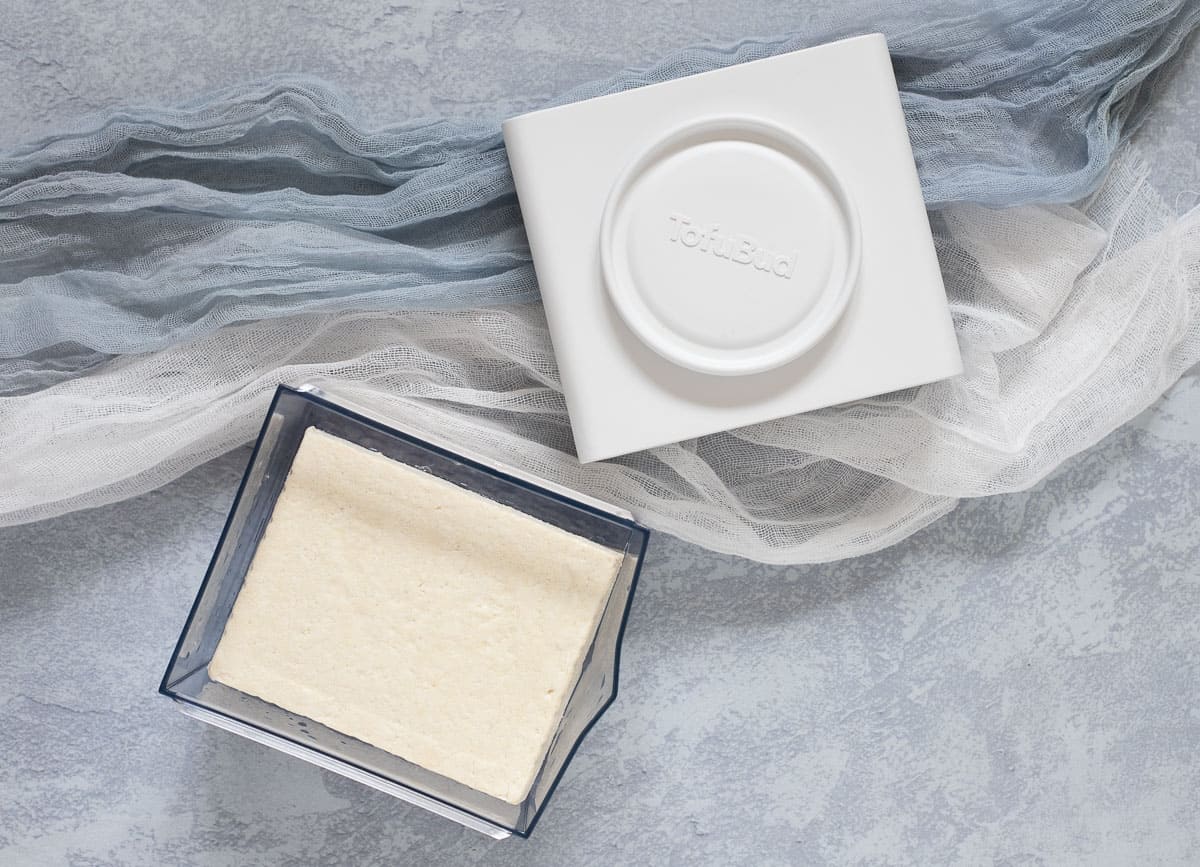
Step 2: Preheat oven to 350 F. Cut the tofu block into equal cubes. In a small bowl whisk together the tamari or soy sauce, and the go-chu-jang sauce.
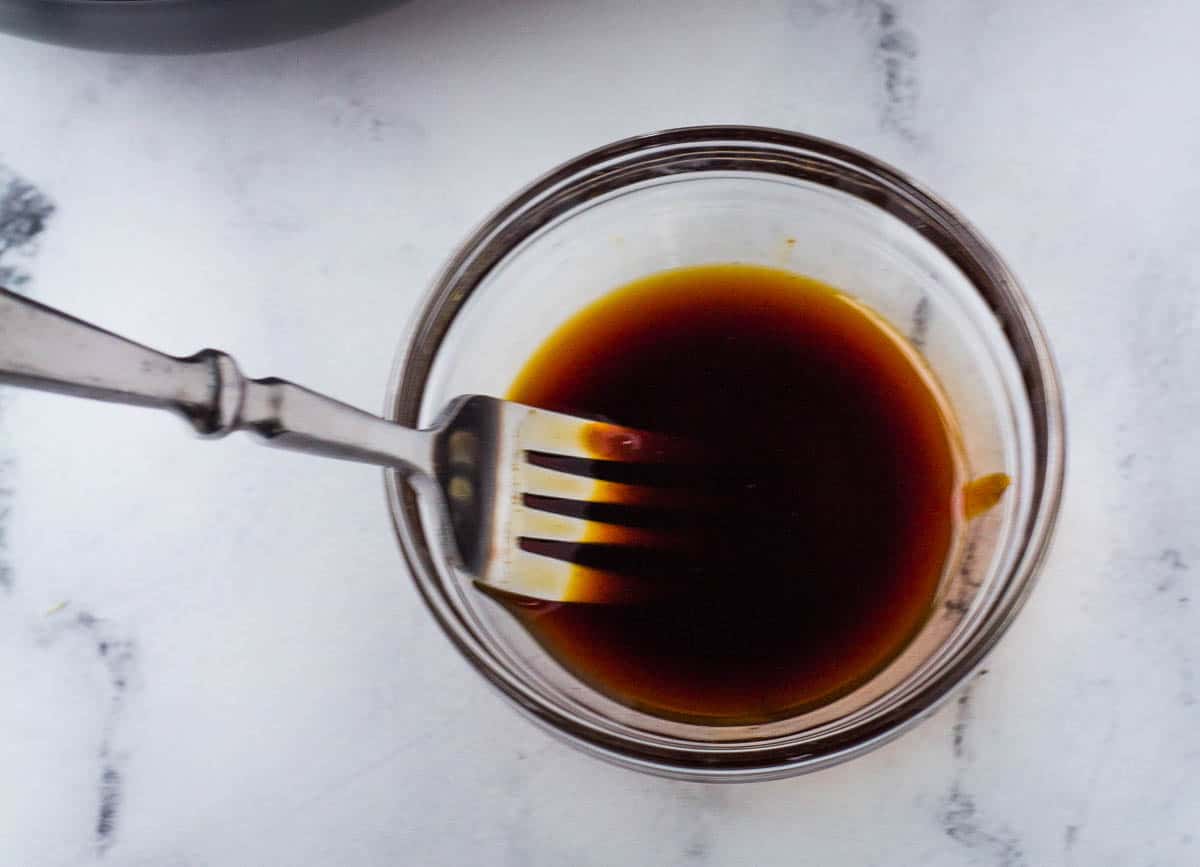
Step 3:Pour the marinade over the cubed tofu. Allow to sit for 10 minutes in the marinade.
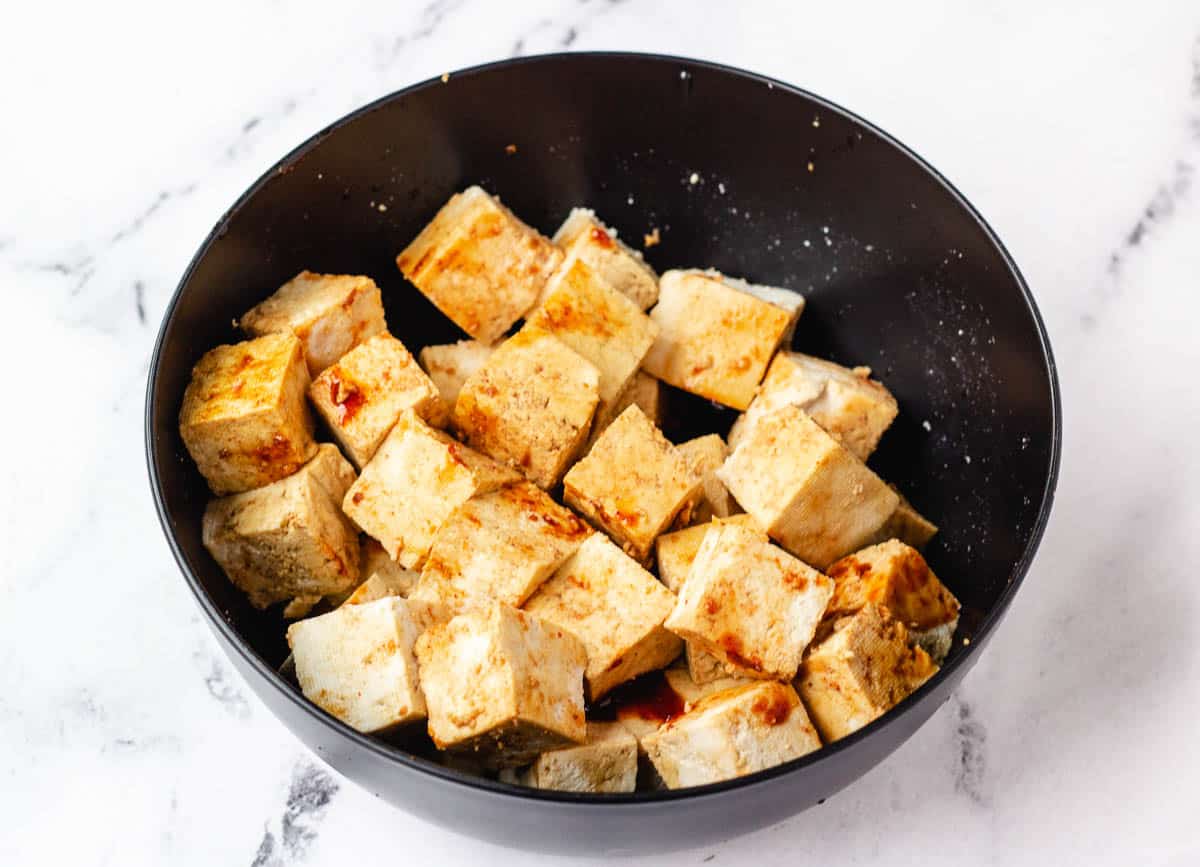
Step 4: Line a baking sheet with aluminum foil. Arrange marinated tofu on the baking sheet. Bake for 20 minutes at 350 F.
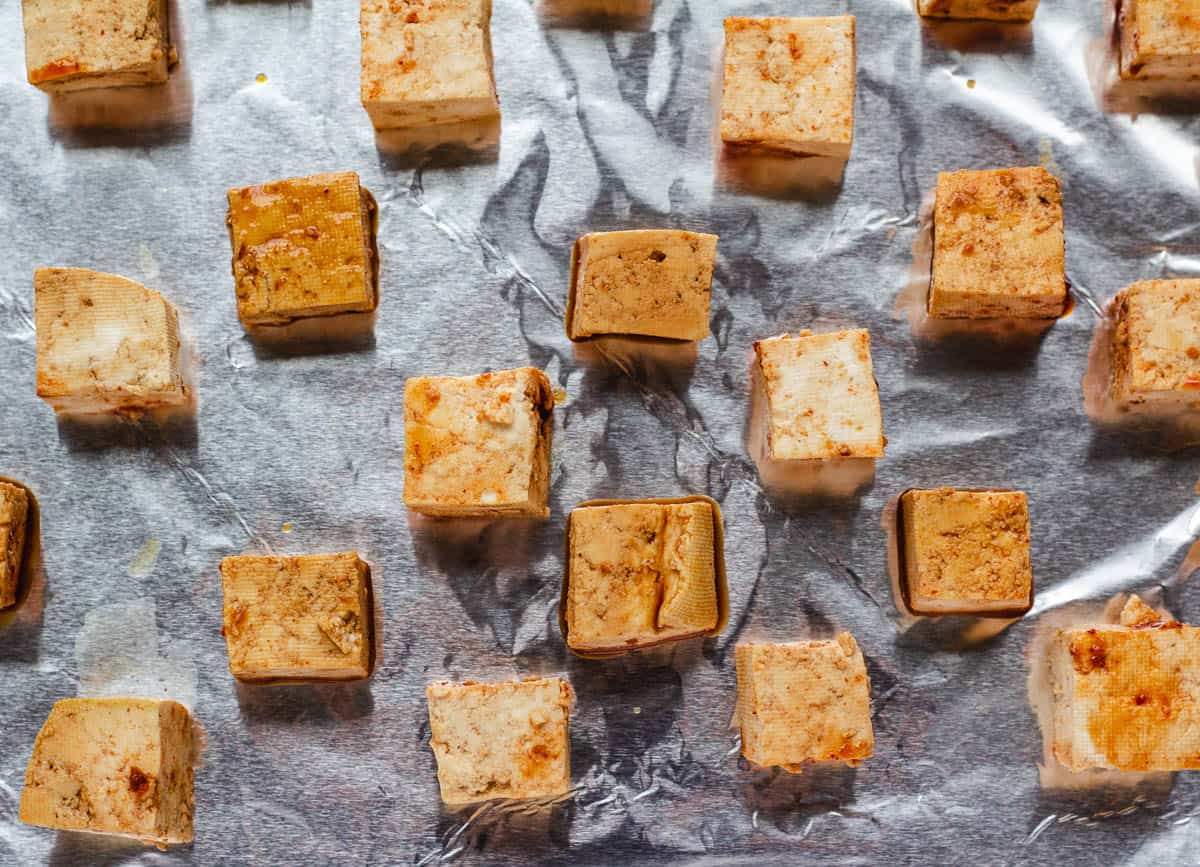
Prepare the Rice
Step 1: While the tofu is baking, combine 1 cup of brown rice with 2 cups of water in a saucepan, and a dash of salt. Bring the rice and water to a boil.
Step 2: Lower the heat, cover, and simmer for 30-45 minutes. Refer to your package for exact cooking time.
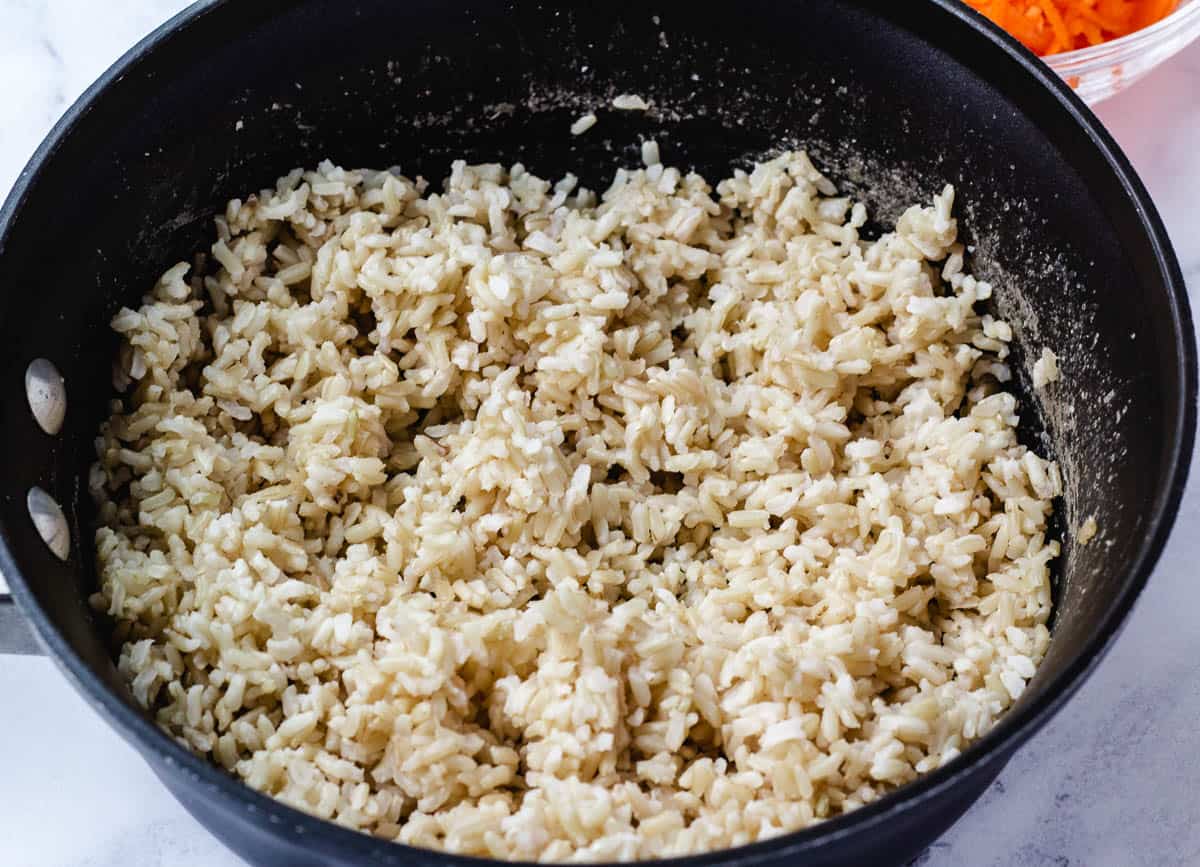
Prepare the Vegetables
Step 1: While the rice is cooking, and the tofu is baking, prepare the vegetables. Peel and grate the carrot, finely slice the cucumber, and radishes using a mandoline or knife.
Step 2: Prepare the mushrooms. In a skillet add 1 tablespoon of tamari. Add the mushrooms. Sauté on medium heat until cooked through. Transfer to a bowl. If you prefer to use oil when sautéing I recommend sesame oil.
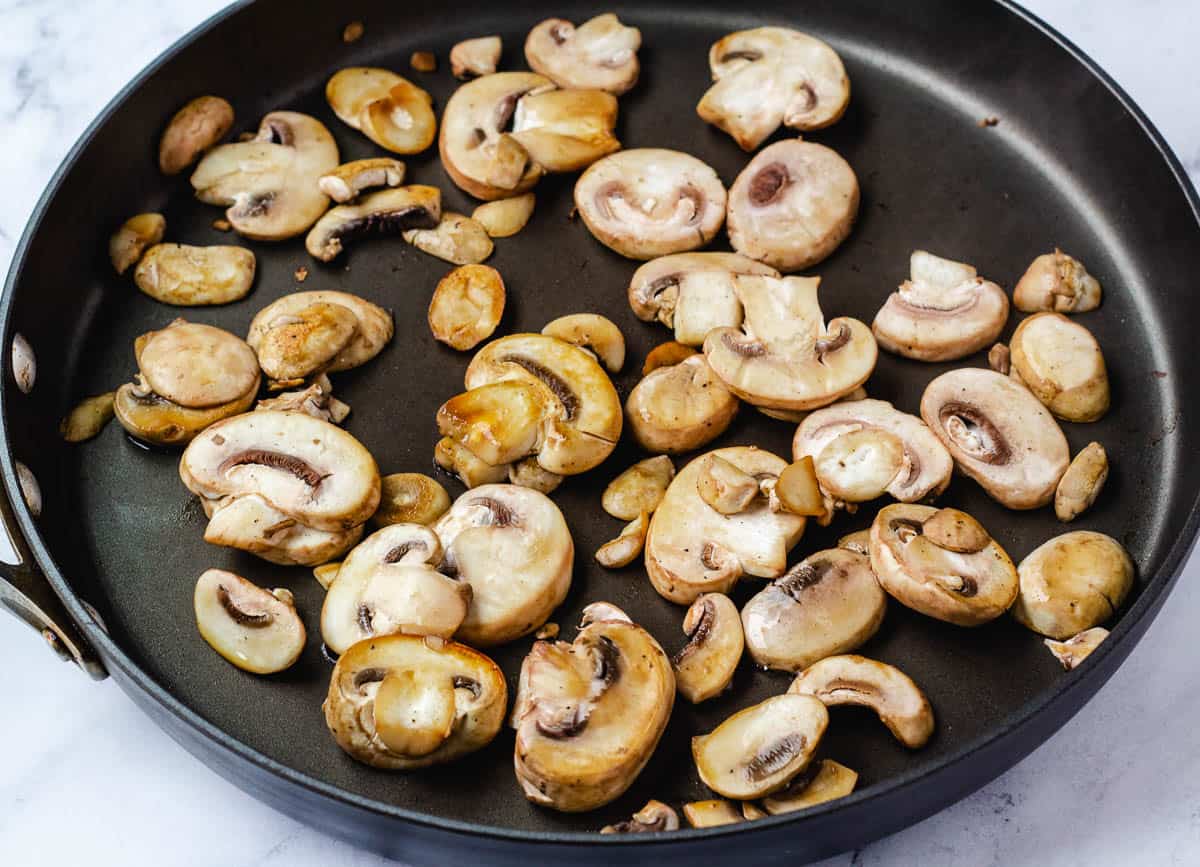
Step 3: Using the same sauté pan, add the spinach. Sprinkle with salt and pepper. Add a touch more tamari or soy sauce if needed. Sauté until spinach wilts.
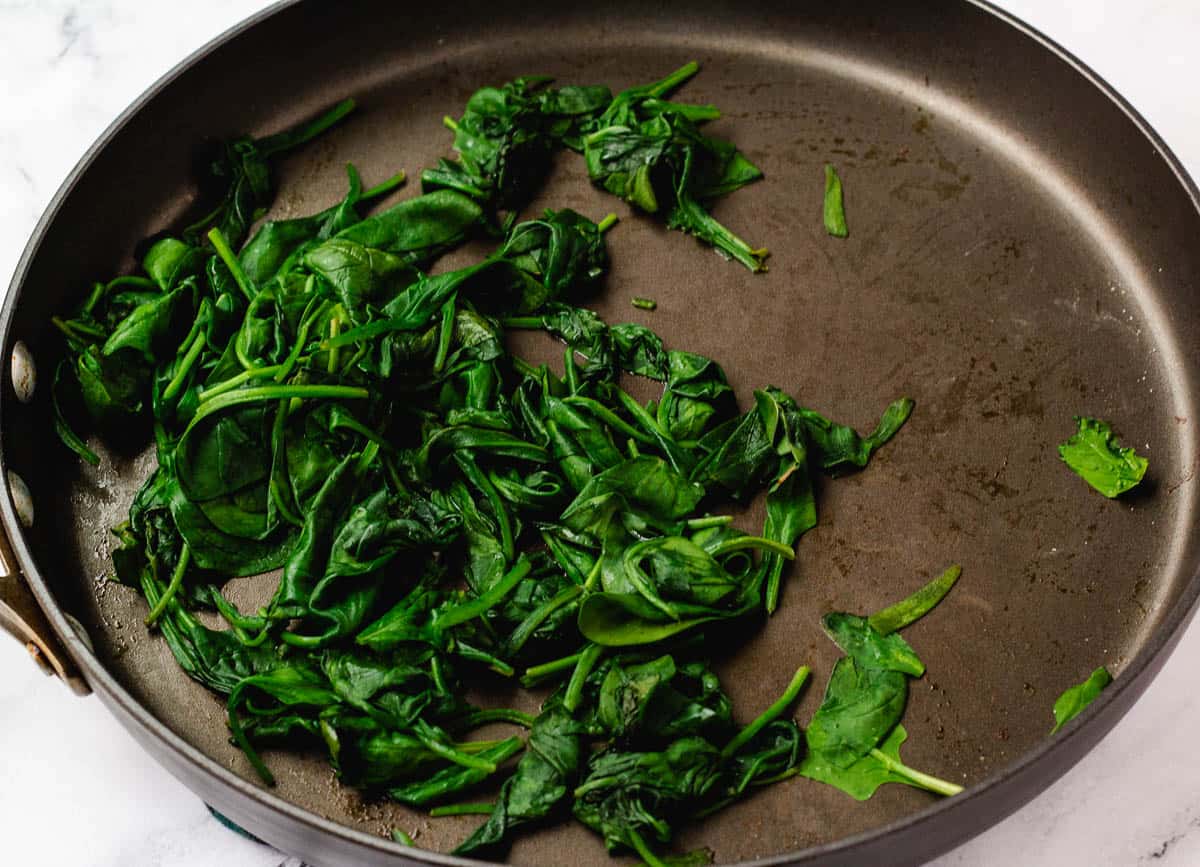
Make the Sauce
Step 1: In a small bowl whisk together the tamari, go-chu-jang, rice vinegar, maple syrup, and garlic.
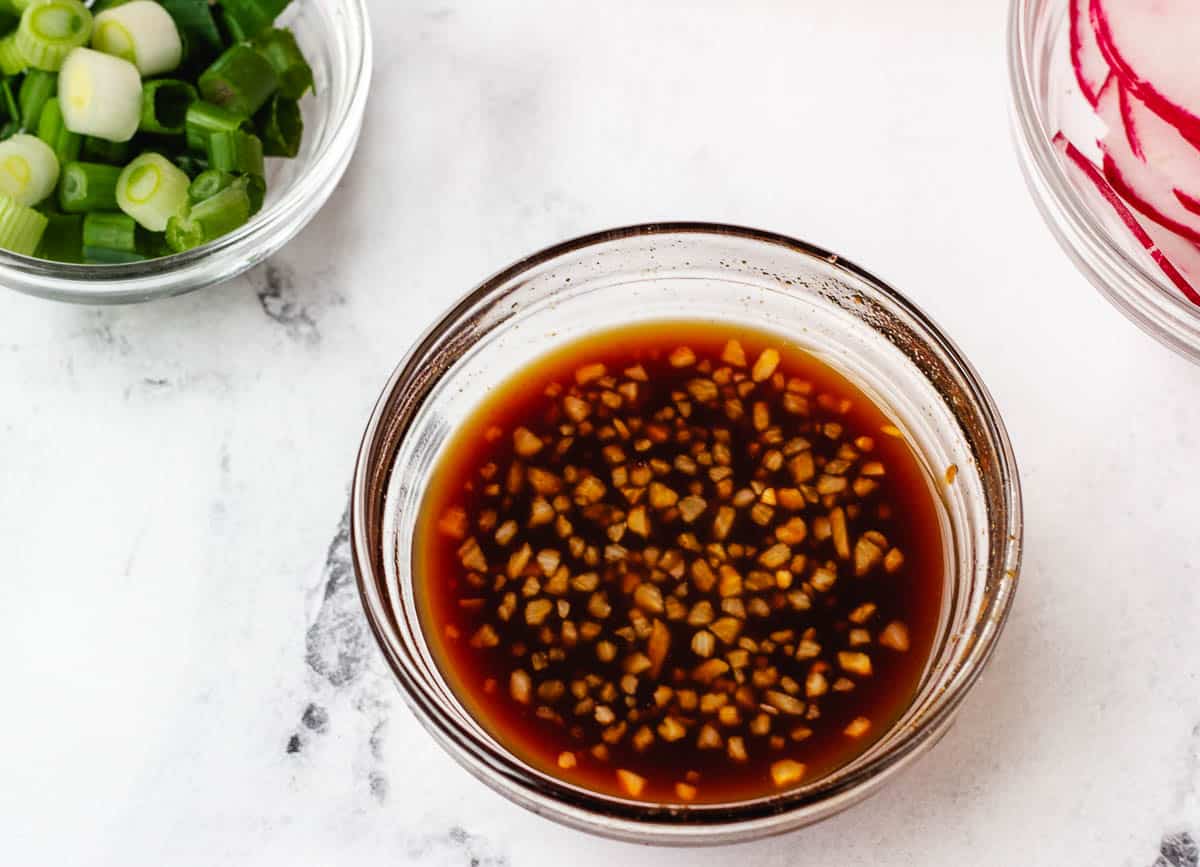
Assemble Your Vegan Bibimbap
Step 1: Using a wide and shallow bowl, add the rice and vegetables around the edge. I like to arrange by color. First, the rice, followed by the carrots, mung beans, radishes, mushrooms, and tofu. Arrange the cucumbers on top. Sprinkle with green onion, and drizzle the sauce over top. Add a few sesame seeds or nori for added color and texture.
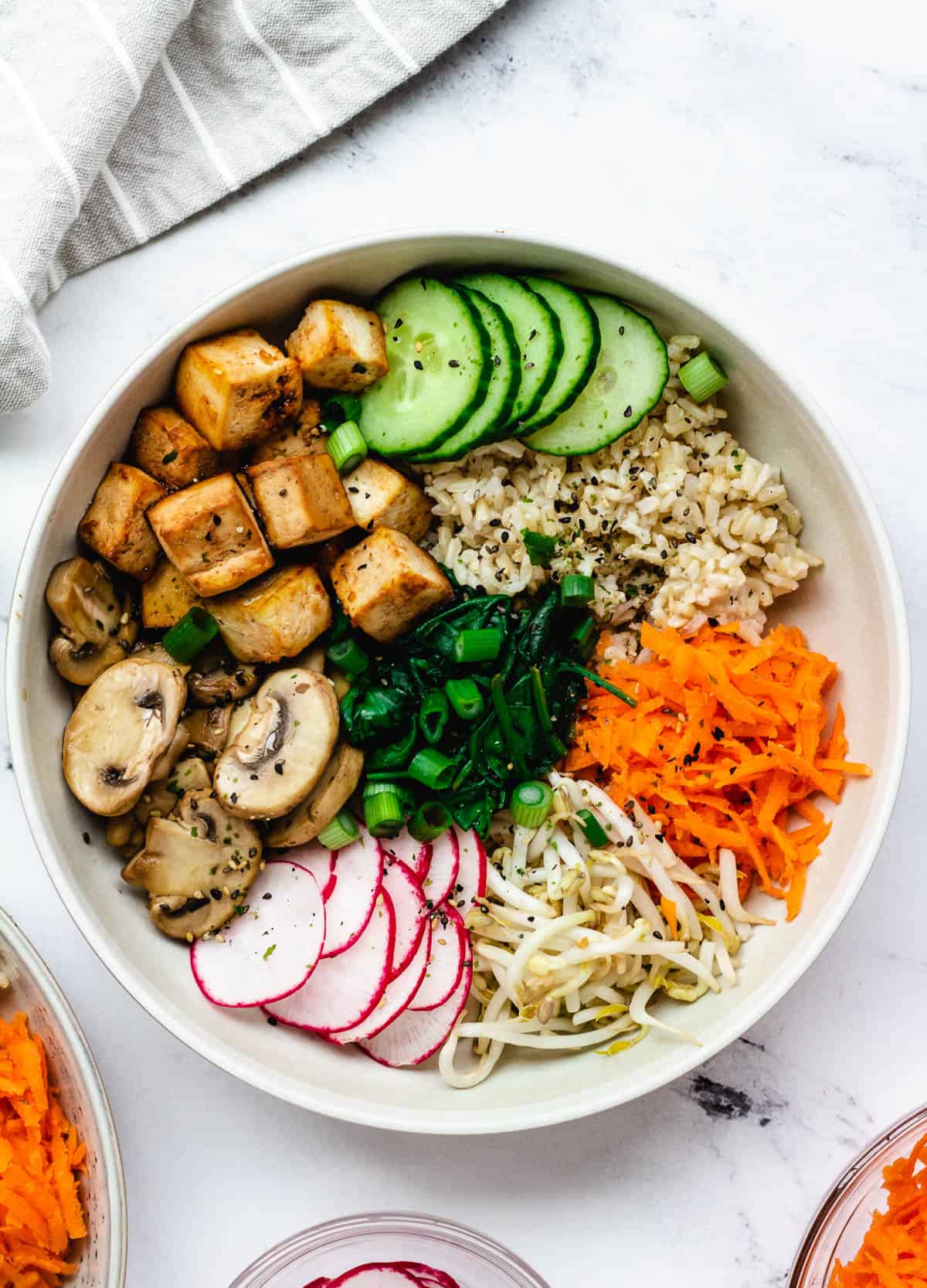
Expert Tips
- Press your tofu ahead of time to save yourself some time.
- Prepare your rice in advance, or use steamed rice bags to save cook time.
- If you have an air fryer you can use it to bake your tofu more quickly.
- Use the go-chu-jang sauce for authentic bibimbap flavor!
- You can use the same pan to sauté the mushrooms and the spinach. Just cook them separately.
- Add a bit of salt and pepper to reduce the water released from the mushrooms and spinach.
Is vegan bibimbap healthy?
Yes! This vegan bibimbap is full of nutritious ingredients!
High in Fiber: The brown rice and all the added veggies give this dish 12 grams of fiber! That’s about half of your daily recommended fiber! Increasing your fiber intake helps with digestion, and keeps you feeling full and satisfied.
High in Plant Protein: The baked tofu in this dish, along with the rice, and veggies gives this recipe 27 grams of plant protein!!
Rich in Vitamins and Nutrients: Eating a colorful array of vegetables in this dish means you’ll be getting a good dose of your daily vitamins and nutrients. Carrots are high in beta-carotene. Radishes are a good source of vitamin C, folate, and riboflavin. Cucumber is packed with vitamin K. Mushrooms are a good source of B vitamins, and spinach is a good source of manganese, magnesium, and iron.
Recipe FAQS
Traditionally, kimchi (fermented cabbage and spices), namul (seasoned greens), carrots, and mung beans. However, you can use up any vegetables that you have on hand. It’s a great way to clean out your vegetable drawer. For this dish, I choose my vegetables based on their color, and flavor.
Short grain white rice is the traditional rice used for this dish. It’s a bit sticky and clings better to the stone bowl to create crunchy rice. In this recipe, I used brown rice to keep this recipe whole food plant-based and increase the fiber.
Go-chu-Jang is a Korean chili paste. It is slightly sweet and spicy with a hint of smoky flavor. It is the signature flavor of bibimbap and is used in other Korean dishes
I used tamari in this recipe, however, you can also use soy sauce. The marinade for the tofu is made with tamari and go-chu-Jang. The sauce that is poured over the top of the rice and vegetables is oil-free. It’s made with tamari, go-chu-Jang, maple syrup, rice vinegar, and garlic. It has a sweet, tangy, spicy flavor that really brings the vegetables, tofu, and rice together with a rich signature flavor.
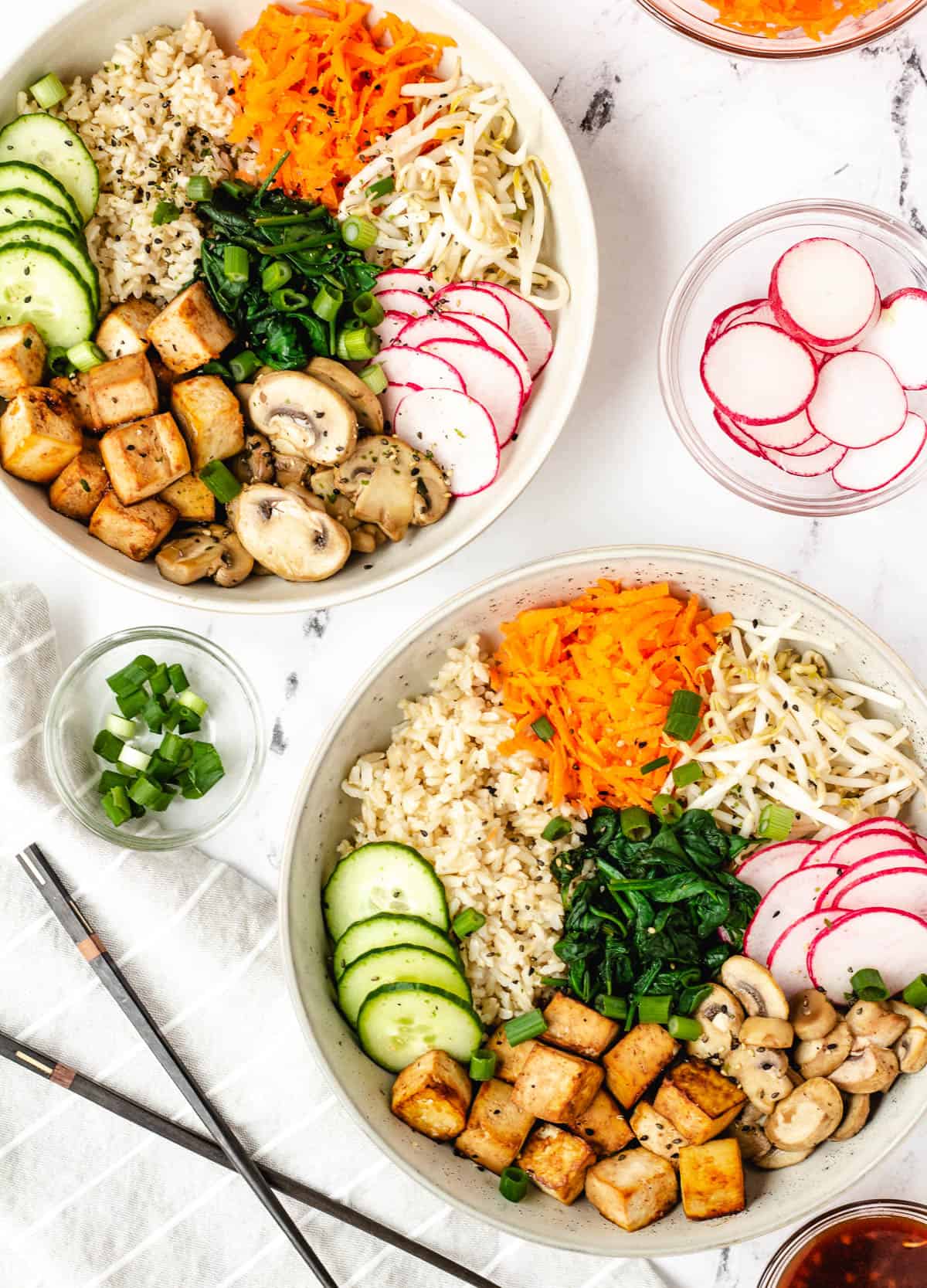
Variations and Substitutions
No Go-Chu-Jang Sauce? While I highly recommend you get this sauce, trust me, once you have it you’ll put it on everything! But if you’re in a bind, and can’t get your hands on it, you can use sriracha instead. Sriracha is spicy without the sweet, so if you mix it with some maple syrup it will taste more like the original.
Use Different Vegetables: If you don’t have cucumber, use zucchini, and if you don’t have radishes, try purple cabbage. Really anything you have you can add to this dish. Just think about the different colors and textures when choosing your vegetables. These Korean Pickled Radishes make the perfect addition!
How to Serve
I like to arrange my bowl with all the colors of the vegetables and tofu around the edge, with the spinach in the center. Then top with the spicy-sweet sauce. When I eat it, I mix it all together, but I love to see all those colors before I stir it up to create the perfect bite!
How to Store, Keep, and Reheat Vegan Bibimbap
Store: I recommend storing each individual component of this dish in a separate glass container in the refrigerator. Place the rice, all the vegetables, the tofu, and the sauce in their own containers. This keeps everything fresh.
Keep: The ingredients, when stored individually should keep for about 3-4 days. After fresh vegetables are sliced, they don’t keep as long, so you may want to eat those carrots, cucumbers, and radishes more quickly!
Reheat: When you’re ready to enjoy this dish again, assemble in your bowl as suggested, and warm in the microwave for about 60 seconds or until heated through. Top with sauce, and enjoy!

More Asian Vegan Recipes!
Recipe
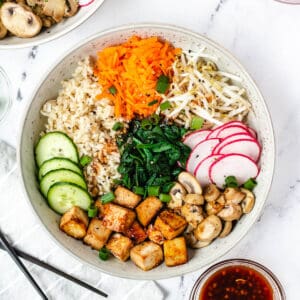
Vegan Bibimbap with Baked Tofu
Ingredients
Vegetables
- 1 large carrot shredded
- ½ English cucumber thinly sliced
- 3 medium red radishes thinly sliced
- 10 oz mushrooms sliced
- 5 oz leaf spinach
- 1 cup mung beans
- 1 tablespoon tamari used to sauté the mushrooms and spinach
- ¼ teaspoon pepper
Tofu
- 14 oz tofu pressed and cubed
- 2 tablespoon tamari or soy sauce
- 1 tablespoon go-chu-jang sauce
Rice
- 1 cup brown rice
- 2 cups water
- ¼ teaspoon salt
Sauce
- 2 tablespoon tamari or soy sauce
- 2 tablespoon go-chu-jang suace
- 1 tablespoon maple syrup
- 2 teaspoon rice wine vinegar
Instructions
Prepare Tofu
- Press the block of tofu for 10-20 minutes to remove the access water. Place several paper towels under and on top of the block of tofu. Place a heavy pot on top. Weight the pot with a few cans or jars. After 20 minutes remove paper towels.
- Cut the tofu block into equal cubes.
- Preheat oven to 350 F. In a small bowl whisk together the tamari or soy sauce, and the go-chu-jang sauce. Pour over cubed tofu. Allow to sit for 10 minutes in the marinade.
- Line a baking sheet with aluminum foil. Arrange marinated tofu on the baking sheet. Bake for 20 minutes at 350 F.
Prepare the Rice
- While the tofu is baking, combine 1 cup of brown rice with 2 cups of water, and a dash of salt.
- Bring the rice and water to a boil
- Lower the heat, cover, and simmer for 30-45 minutes. Refer to your package for exact cooking time.
Vegetables
- Prepare the mushrooms. In a sauté pan add 1 tablespoon of tamari, and a pinch of pepper Add the mushrooms. Sauté on medium heat until cooked through. Transfer to a bowl.
- Using the same sauté pan, add the spinach. Sprinkle with pepper. Add a touch more tamari if needed. Sauté until spinach wilts.
Prepare the Sauce
- In a small bowl whisk together the tamari, go-chu-jang, rice vinegar, maple syrup, and garlic.
Assemble
- Using a wide and shallow bowl, add the rice and vegetables around the edge. I like to arrange it by color. First the rice, followed by the carrots, mung beans, radishes, mushrooms, and tofu. Arrange the cucumbers on top. Sprinkle with scallions, and drizzle the sauce overtop. Add a few sesame seeds, or nori for added color and texture.
Video
Notes
- Press your tofu ahead of time to save yourself some time.
- Prepare your rice in advance, or use steamed rice bags to save cook time.
- If you have an air fryer you can use it to bake your tofu more quickly.
- Use the go-chu-jang sauce for authentic bibimbap flavor!
- You can use the same pan to sauté the mushrooms and the spinach. Just cook them separately.
- Add a bit of garlic, salt and pepper to reduce the water released from the mushrooms and spinach.


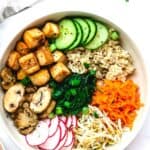
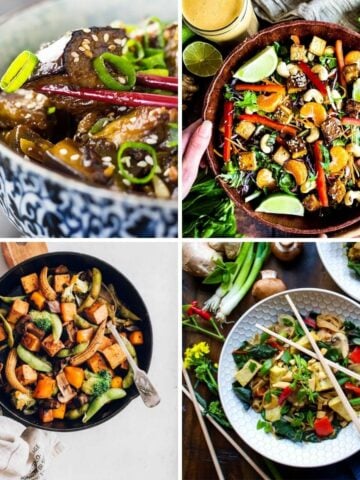
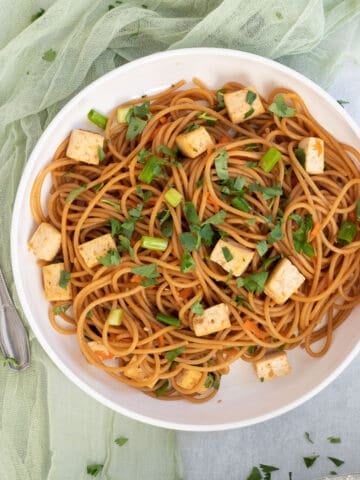
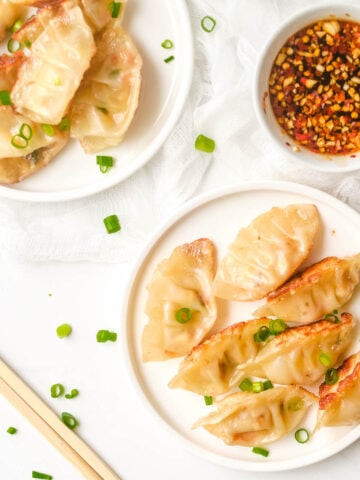
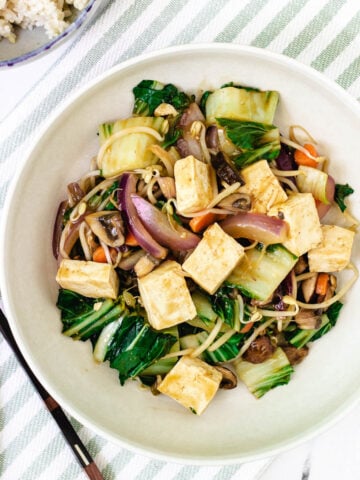
veenaazmanov
Such a lovely combination of health and goodness. This Bowl is definitely a Happy Meal option.
Beth
This looks so delicious and so tasty! My husband is going to love this recipe! So excited to give this a try!
simi
This colorful SuperBowl is so so delicious. And it’s vegan too. I loved this vegan bibimbap. It’s so delicious and easy with your instructions.
Jess
The colors in this dish are so pretty! I love that there are mushrooms in this. Yummy!
Anjali
I love bibimbap but never felt comfortable enough to make it at home — I only ever ordered it when we ate out! But your recipe was super easy to make and turned out to be incredibly flavorful!! I’ll be making this again and again!